Accepted Scientific Name: Latania loddigesii Mart.
Hist. Nat. Palm. 3: 226 (1838) Mart.
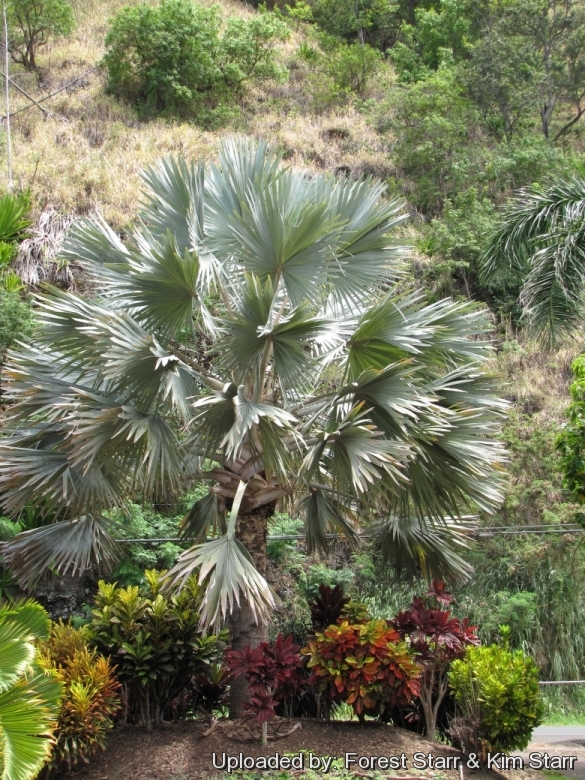
Cleophora loddigesii (Latania loddigesii) Photo by: Forest Starr & Kim Starr
Habit at Tropical Gardens of Maui Iao Valley Rd, Maui, Hawaii (USA). July 20, 2009.
Origin and Habitat: Endemic to the little Round Island (Ile Ronde) in the Mascarene Islands Archipelago (Mauritius)
Habitat: It grows often in association with screwpines (Pandanus Vandermeschii) in the original dry, open, forest between the two tableland in the south of the island on barren, rocky slopes and ravines (mostly western faced) with the apparent lacking of soil. No other vegetation is found except sparse tufts of Portulaca oleraceaSN|29334]]SN|29334]] and Nicotian tabacum. Two other trees, the Bottle palm (Mascarena revaughaniiSN|24508]]SN|24508]]) and a Hurricane palm (Dictyosperma albumSN|24395]]SN|24395]]) both formely numerose are now reduced to very few individuals. The climate is characterized by marked seasonal traits, with warm and rainy summers and dry winters. Latania loddigesii is endangered; a few mature specimens survive, but it is by far the most abundant tree species Latania on Round Island. The number of young lantanis has recently dramatically increased thanks to the institution of a natural reserve along with the rabbit/goat eradication from the area.
More...Synonyms:
See all synonyms of Latania loddigesii
back
Accepted name in llifle Database:Latania loddigesii Mart.Hist. Nat. Palm. 3: 226 (1838)Synonymy: 5
back
Common Names include:
ENGLISH: Silver latan palm, Blue latan palm, Blue latan, Blue Latania Palm
CHINESE (中文): Lan zong lü, Lan se la ta zong
FRENCH (Français): Latanier bleu
GERMAN (Deutsch): Mauritiuspalme, Latan-Palme, Latanpalme, Lataniapalme, Blaue Latanpalme
Description: Latania loddigesiiSN|28506]]SN|24512]] is a very attractive fan palm noted for its distinctive, blue coarse-textured leaves. This small, slow-growing, solitary palm is closely related and often confused with Bismarckia nobilisSN|24223]]SN|24223]] from Madagascar.
Trunk: Single, upright, up to 25(-30) cm in diameter, 6-10 m tall, dark grey, marked by irregular, slightly raised, reddish scars of the fallen off leaves and with a noticeable thick, swollen base and narrows upward, like a bottle.
Crown: Symmetrical, quite open 3-4,5 m in diameter, frond arranged in spiral
Leaves: Costapalmate (star-shaped), induplicate, large, very thick and stiff , 1,5-2,5(-3) m in diameter, held aloft on 1,5 m long petioles. The surface of each leaf is covered with a whitish, waxy or wooly down (denser on the underside), providing a bluish-grey silvery appearance to the palm. The leaf sheath splits to form a V-shape below the petiole. Leaflets about 1/3 to 1/2 the length of the leaf blade single-fold, rigid with undivided and sharp tips. Leaf margin entire to slighty serrulate. Petiole smooth and sharp-edged or armed with minute teeth along the margin near its base, and the hastula is flat and somewhat arrow-shaped.
Inflorescence: Dioecious plant (each individual carries only masculine or feminine flowers) present among the leaves in spring. Masculine inflorescences shorter (up to 1 m long) and more ramified. Feminine inflorescence are longer (up to 2 m long) and simpler. Flower not showy creamy-white to yellowish-brown.
Fruit: Oval about 3-7,5 cm long, glossy grey-green to brown when ripe. The fruits are fleshy similar to those of a peach or apricot in that a sculptured woody endocarp (pit) with a encloses smooth almond-shaped seed. In general a fruit contain, in general, three seeds.
Seeds: The seeds are divided in 3 at the bottom like a "trident". In fact all 3 Latanias are very dictinguishable by their there seeds. The Red Latania (Latania lontaroides) is in fact the easier and quicker to sprout than the 2 others and the seeds are thick and short with little patterns. The Blue Latania (Latania loddigesii) seeds are more nicely patterned and Yellow Latania (Latania verschaffeltii) seeds are long and thin and the patterns are parallel , also at the bottom it ends like a " trident " and the fruits of that are longer and slender than the Blue Latania
Phenology: Blooms appears in spring often along with some of the fruits that are always ripening.
Remarks: The three different species of Latan Palm can be distinguished by leaf colour. Only young leaves that have not yet turned silvery should be used for this determination. Latania loddigesii (Blue Latan Palm) has blue-grey leaves. Latania lontaroides Red Latan Palm) has reddish petiole, leaf margins and veins. Latania verschaffeltiiSN|24512]]SN|28506]] (Yellow Latan Palm) has leaf margins, veins, and petioles which are deep orange-yellow, but within 3-5 years they all sort of turn to a grey colour.
More...Bibliography: Major references and further lectures
1) Johnson, D. 1998. “Latania loddigesii.” The IUCN Red List of Threatened Species. Version 2014.2. <www.iucnredlist.org>. Downloaded on 30 August 2014.
2) Forest & Kim Starr Latania loddigesii (Blue latan palm). Plants of Hawaii. <http://www.starrenvironmental.com>. Downloaded on 21 August 2014.
3) John Dransfield, Natalie W. Uhl “Genera Palmarum: the evolution and classification of palms” Kew Pub., 2008
4) Wikipedia contributors. "Latania loddigesii" Wikipedia, The Free Encyclopedia. Wikipedia, The Free Encyclopedia, Accessed on 28 Aug. 2014
5) Don Ellison, Anthony Ellison “Cultivated Palms Of The World” UNSW Press, 01/May/2001
6) Robert Lee Riffle, Paul Craft “An Encyclopedia of Cultivated Palms” Timber Press, Portland 2007
7) " Latania loddigesii ." PACSOA Palms and Cycads wiki , <http://www.pacsoa.org.au> Accessed on 28 Aug. 2014
8) Palmpedia contributors. "Latania loddigesii ." Palmpedia, PALM ENCYCLOPEDIA, <http://www.palmpedia.net> Downloaded on 26 Aug. 2014
9) Jones, D. L. “Palms throughout the world.” 1994
More...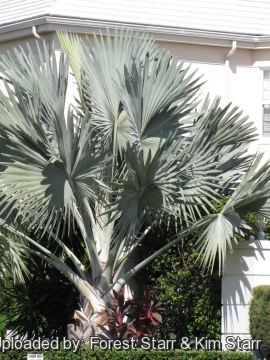 Habit at Boynton Beach, Florida. September 25, 2009. (Latania loddigesii) Photo by: Forest Starr & Kim Starr
Habit at Boynton Beach, Florida. September 25, 2009. (Latania loddigesii) Photo by: Forest Starr & Kim Starr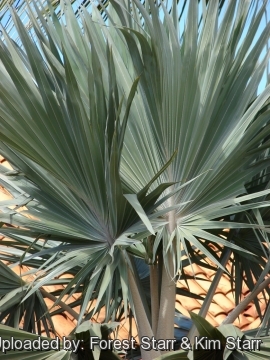 Fronds at Kaanapali, Maui, Hawaii (USA). February 21, 2007. (Latania loddigesii) Photo by: Forest Starr & Kim Starr
Fronds at Kaanapali, Maui, Hawaii (USA). February 21, 2007. (Latania loddigesii) Photo by: Forest Starr & Kim Starr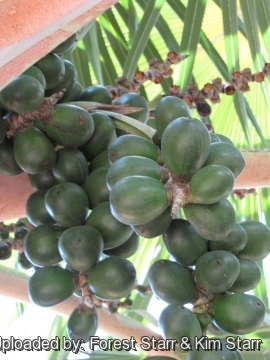 Fruit at Iao Tropical Gardens of Maui, Maui, Hawaii (USA). May 22, 2012. (Latania loddigesii) Photo by: Forest Starr & Kim Starr
Fruit at Iao Tropical Gardens of Maui, Maui, Hawaii (USA). May 22, 2012. (Latania loddigesii) Photo by: Forest Starr & Kim Starr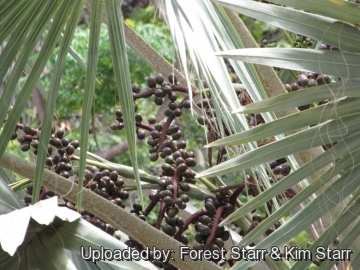 Leaves and fruit at Tropical Gardens of Maui Iao Valley Rd, Maui, Hawaii (USA). July 20, 2009. (Latania loddigesii) Photo by: Forest Starr & Kim Starr
Leaves and fruit at Tropical Gardens of Maui Iao Valley Rd, Maui, Hawaii (USA). July 20, 2009. (Latania loddigesii) Photo by: Forest Starr & Kim Starr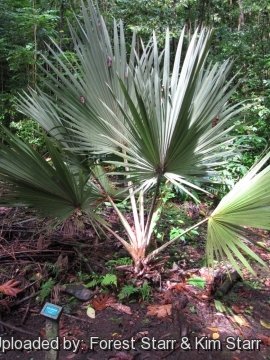 Habit and sign at Keanae Arboretum, Maui, Hawaii (USA). February 16, 2012. (Latania loddigesii) Photo by: Forest Starr & Kim Starr
Habit and sign at Keanae Arboretum, Maui, Hawaii (USA). February 16, 2012. (Latania loddigesii) Photo by: Forest Starr & Kim Starr Habit at Boynton Beach, Florida. September 25, 2009. (Latania loddigesii) Photo by: Forest Starr & Kim Starr
Habit at Boynton Beach, Florida. September 25, 2009. (Latania loddigesii) Photo by: Forest Starr & Kim StarrCultivation and Propagation: It is a very tough and adaptable palm that enjoys sun, heat and dry conditions.
Soil tolerances: It likes fertile, sandy soil, but is adaptable to different soil type (clay; loam; slightly alkaline or acidic) and grows even in poor lands, provided they are well drained. The root system of this species is very sensitive and good sized specimen is extremely difficult to successfully dig and transplant to another location.
Growth rate: Usually slow but relatively fast in favourable tropical climates.
Fertilization: Need a perfect fertilizer diet including all micro nutrients and trace elements or slow release fertilizer, but particularly it is needs plentiful of magnesium. If it doesn't get enough magnesium, the leaves take on a rather unhealthy yellow colour.
Watering: It thrives in fairly dry and hot climates, but enjoy also rainy climates and proved to tolerate a wide variety of conditions. In areas where summer rain is prevalent, it seems to put on rapid growth with this ample water, but it does not want to sit in continually wet, mucky soil. When adult, it can bear long drought periods.
Light: Prefers full sun from a very young age but will tolerate half day sun.
Hardiness: Some cold tolerance. This palm has tolerated temperatures down to –2ºC for very short periods and even a little snow. However it can be difficult to get it to look its best without a great amount of heat and sun and so it is only really suited to the tropics, subtropics and in particular favourable Mediterranean microclimates in frost-free regions. (USDA hardiness zones 10b-11)
Aerosol salt tolerance: It is well-suited to seaside locations due to its moderate salt-tolerance, but does a lot better inland then it does on the coast.
Maintenance: Prune diseased, damaged or drying fronds, but do not prune if the frond still has some green colour. Palms recycle nutrients from dead or dying fronds and use them for healthier fronds. Palms only have a set number of new leaves that can sprout and grow per year and removing fronds will not increase that number. If you cut off more than what will grow annually, you could be left with a pretty bare and bald Palm.
Propagation: Seed which germinate in about 30 days if fresh and with bottom heat. The seedlings are very attractive.
Use: It is a plant of great ornamental value either as a single specimen or in groups. Its very neat appearance makes it perfect near highways and used to accent residential landscapes. Plant it in an area where you would like to attract attention. People's eyes will always be drawn to this plant, no matter where it is planted. It can be placed very satisfactorily in situations where a low- growing palm is required. Culture in containers is possible although growth rates are slower. A shade screen patio will provide an excellent environment for young specimens which can eventually be planted in a sunny location.
Roots: not a problem.
Pest & Diseases: It is susceptible to lethal yellowing disease, and so should be used sparingly in the landscape.
More...















